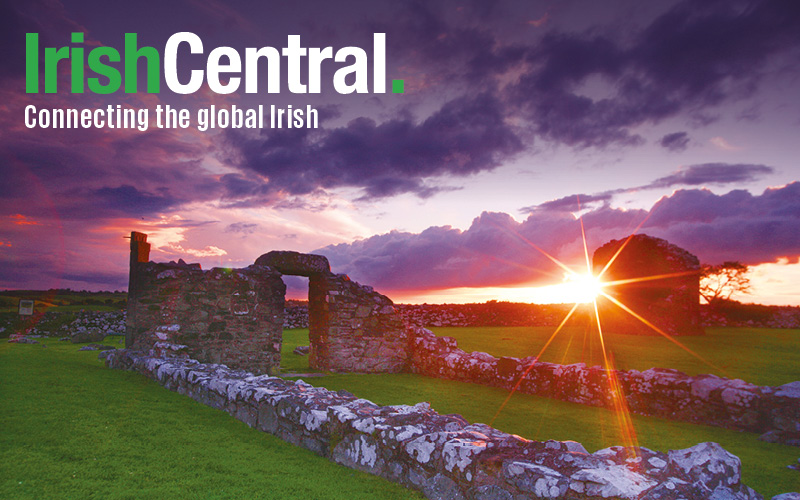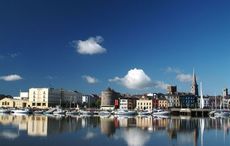THE SHANNON REGION PHOTO GALLERY/CLICK HERE
Let’s set off on a journey through the Shannon region, a joyrney that will expose us to different eras of Irish history and different aspects of modern-day Irish culture in an area that encompasses counties Clare, Limerick, North Tipperary, South Offaly and North Kerry.
In this feature we will explore the delights of County Clare. Don’t worry about the jet lag. Your sense of time is about to be scrambled as it is!
“It’s a long, long way from Clare to here.” So go the words ofthe popular song. But is it really true? What with ShannonAirport’s ever-increasing network of connections with U.S.cities, it may not take you as long as you think to arrive in CountyClare – one of Ireland’s most culturally and geographicallydiverse counties.
You’ll find that it’s certainly worth the journey. This is a county whose history stretches back millennia and its rich archaeologyis testament to this. Dotted across the landscape are Stone Ageburial sites built by Clare’s earliest inhabitants; Celtic high crosseserected by early Christians; round towers used by monks asprotection against marauding Vikings; and ruined medievalmonasteries and castles.
These historical sites are set in stunning scenery. Clare’s naturalbeauty includes soaring sea cliffs, playful dolphins and theotherworldly limestone landscape of the Burren with its multitudeof rare flora and fauna.
Clare’s people are interesting too. This county has producedsome of Ireland’s best traditional musicians –accordionist Sharon Shannon and fiddler Martin Hayesare two of the most famous. Its people also have a passionfor hurling, the sport mythologized by Cúchulainn, a heroof Old Ireland.
Our first stop after Shannon Airport is Bunratty Castle.Built in 1425 and restored in 1954, it’s Ireland’s most completeand authentic medieval fortress. As you cross over thedrawbridge, you’ll feel as though you’ve traveled hundredsof years back in time.
You’ll learn all about the hierarchy of life in the castleas you wander from room to room. The marble floor, oakceiling, richly-colored tapestries and hunting horns ofthe Great Hall testify to the leisured life of the gentry,while the rough wooden boards and straw matting thatservants slept on convey just how impoverished theirlives must have been.
There’s a folk park in the grounds of the castle whereyou can learn how the ordinary people of Ireland lived inbygone times. Marvel as daily life is recreated in ruralfarmhouses and village shops. Watch as women cooksoda bread on open fires and churn butter before yourvery eyes. They may even give you a slice of warm breadslathered with freshly-made butter when it’s ready.
You can keep up the pretense of time-traveling all daylong if you like. Banquets are held in the castle mostevenings. At these events, you’ll be entertained by musicianssinging medieval madrigals and kilted pipers playingtraditional tunes while you sit at a candlelit long oaktable eating dishes from the medieval era washed downwith mead, the honeyed drink of the gods.
Once you’ve tired of medieval life in Bunratty, you canexplore river life in Killaloe. Sitting on the banks of LoughDerg, Ireland’s pleasure lake, this is a town of charmingnarrow streets that wind up a steep hillside and overlook a13th-century cathedral. It is also the hometown of perhapsthe best known of Ireland’s high kings, Brian Ború.
This 11th-century king must have navigated the waters ofthe Shannon in his time and you can follow in his footsteps(or should that be slipstream?) by chartering your owncruiser. A few days of slow-paced riverboat life, watchingthe countryside glide by, should leave you feeling utterlyrelaxed.
And ready for more exploration? Having regained yourland legs, head for the village of Tulla. A fishing centerbased around three lakes, Tulla boasts a medieval parishchurch and seven megalithic tombs. It also has a strongmusical heritage. The Tulla Céilí Band is known for itsrousing renditions of traditional music. Fishing, uncoveringthe secrets of the past and Irish dancing – you can do it allin Tulla.
By this stage, you may be missing the bustle of the bigtown. Fortunately, Ennis is only a few miles away. One ofIreland’s most picturesque towns, you’ll find plenty toamuse you here.
The old town is divided by the River Fergus, whichmeans there are lots of riverside walks through the town. You can explore the 13th-century friary, wander throughthe winding streets and browse in its old shops while gabblinggeese and dabbling ducks play alongside.
Ennis is also known for contemporary culture. Its art galleriesshowcase the works of modern-day Irish artists. And Glór, its state-of-the-art performance center, attracts the bestnational and international acts.
Having had your fill of Irish culture – Clare style – it’stime to explore Clare’s most unique landscape, the Burren.Leave Ennis behind and head north.
Before you arrive in the Burren proper, stop off for a walk in Dromore Woods, just outside Ruan. This nature reserve ofrivers, lakes, flooded meadows, peat bogs and reed beds isrich in woodland species. Who knows what you’ll see as youwander?
You should always anticipate the unexpected in theBurren. Consisting of 250 square kilometers of limestone,it’s an environment unlike any other. Here, Arctic,Mediterranean and Alpine plants grow side by side, colorfulflowers growing out of the crisscrossing cracks in the rock.
The Burren, often referred to as Ireland’s rock garden, isan archaeological phenomenon, paradise for walkers,cyclists, and artists. The Stone Age people who lived hereleft behind dolmen structures, single-chamber tombs that areusually made from three or more upright stones. Later inhabitantsleft ancient cooking sites – known as fulachta fiadh –and others built the hundreds of ring forts that still dominatethe landscape.
Exploring all of these attractions would take months, sohere are some highlights. Caherconnell Fort was built morethan 1,000 years ago and occupied as late as the 17th century. It’s been scientifically excavated and developed fortourism. You can follow its stone pathways to the past asaudiovisual displays tell the stories of the lives lived in thefort over the centuries.
Nearby is perhaps the most famous dolmen of all –Poulnabrone. Translated as the Hole of Sorrows in Irish, thisdolmen has stood starkly against the limestone landscapesince at least 3800 B.C.
Feeling invigorated, you should head for the coastal town of Doolin. This fishing village has long been a center for Irishtraditional music. Its three pubs trill to the sounds of jigs andreels every night of the week.
Having spent the evening in the pub, you can spend thefollowing day exploring the great outdoors (or should that bethe great underground?). Aillwee Cave is full of subterranean surprises. Formed by the glacial melt-waters of the last IceAge, the cave boasts caverns, chasms and even a frozenwaterfall. Doolin cave is home to the largest accessible stalactitein the world.
Back above ground, your next stop is one of Ireland’s most spectacular natural vistas – the Cliffs of Moher (featured in the new Harry Potter movie). At 702 feet above the ocean,these sea cliffs offer wonderful views of the Aran Islands and of the valleys and hills of Connemara in the next county.
You may feel energized by these fabulous views. If so,head to Doonbeg for a game of golf on a championshipcourse which is ranked among the best in the world. It alsooffers five star accommodation at the lodge.
And if you’re feeling even more adventurous, take surfinglessons. Lahinch, and indeed the entire Clare coastline, offerssome of the best surfing in all of Europe.
Further down the road, Spanish Point – named after theSpanish Armada which was wrecked off the coast in 1588 –also offers golfing in one of the oldest courses in Ireland andperhaps the best surf break in Clare. You can choose betweenthe two or, better yet, try both.
You can recover from your exertions in the local hostelriesor in nearby Ennistymon. Known for its 16th-century castle and traditional shop fronts, this is a riverside market townwith character.
Once you’ve replenished your energy, you can continueyour coastal meanderings. Take in the sea cliffs. Marvel atthe bird life. Watch out for dolphins and whales. And soakin all the history and scenery until you come to the remoteLoophead Peninsula. With gulls circling overhead andancient monuments to be seen on the horizon, the hubbub ofcity life will feel very far away.
Your journey is now almost over but if you’ve still got timeto spare, pay a visit to Scattery Island at the mouth of the RiverShannon. This has been an ecclesiastical center since earlyChristian times. A monastery was founded here in honor of StSenan in the 6th century. Some of it – several churches and around tower – stands to this day.
Finally, before heading back to Shannon, stop off to visit the Shannon Dolphin and Wildlife Foundation in Kilrush. Here,you can learn all about the huge variety of local wildlife, especiallythe dolphins who are so attracted to the area.
And before you go home, try to catch a game of hurling.Witnessing the clash of the ash is an experience that will never be forgotten and there are few places where hurling is playedwith such passion as Clare.
And, if it truly is a long, long way from Clare to here, whoknows when you’ll get the opportunity again?




Comments